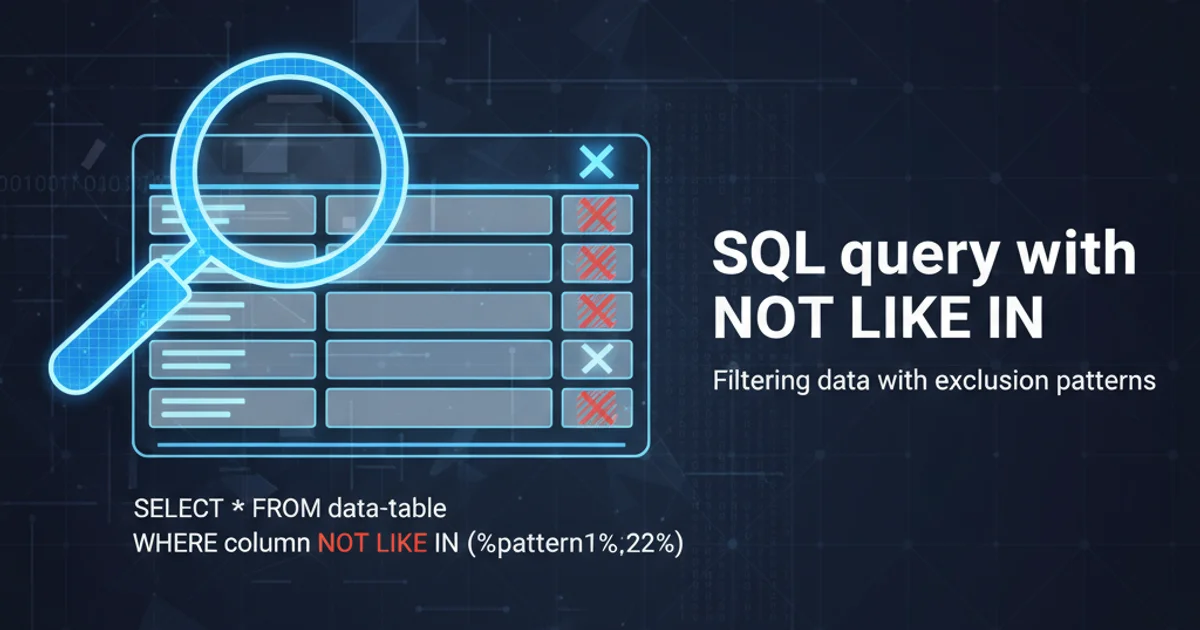SQL query with NOT LIKE IN
Mastering SQL NOT LIKE IN for Advanced Pattern Exclusion

Explore how to effectively use the NOT LIKE operator in SQL, especially when combined with IN or multiple NOT LIKE clauses, to filter out data based on complex pattern matching in SQL Server 2008 and T-SQL.
In SQL, the LIKE operator is fundamental for pattern matching, allowing you to search for specific character patterns within string columns. However, there are scenarios where you need to exclude data that matches certain patterns. This is where NOT LIKE comes into play. While NOT LIKE is straightforward for a single pattern, combining it with multiple patterns, similar to how IN works with equality, requires a deeper understanding of logical operators. This article will guide you through using NOT LIKE effectively, particularly when dealing with multiple exclusion criteria in SQL Server 2008 and T-SQL.
Understanding NOT LIKE for Single Pattern Exclusion
The NOT LIKE operator negates the LIKE operator. If LIKE finds a match, NOT LIKE will return false, and vice-versa. It's used to retrieve rows where a string column does not match a specified pattern. The wildcard characters commonly used with LIKE and NOT LIKE are:
%: Represents zero or more characters._: Represents a single character.
Let's consider a simple example where we want to exclude all products whose names start with 'A'.
SELECT ProductName, Category
FROM Products
WHERE ProductName NOT LIKE 'A%';
SQL query to select products whose names do not start with 'A'.
Excluding Multiple Patterns: The Challenge with NOT LIKE IN
Unlike the IN operator, which allows you to specify a list of exact values to match against (e.g., WHERE Category IN ('Electronics', 'Books')), there isn't a direct NOT LIKE IN construct in SQL. If you try to use NOT LIKE with multiple patterns separated by commas, it will result in a syntax error. The common mistake is to assume NOT LIKE ('Pattern1%', 'Pattern2%') would work, but it doesn't. To exclude multiple patterns, you must combine multiple NOT LIKE clauses using logical operators, typically AND.
flowchart TD
A[Start Query] --> B{Evaluate Row}
B --> C{"ProductName NOT LIKE 'A%'"}
C -- True --> D{"ProductName NOT LIKE '%B'"}
C -- False --> E[Exclude Row]
D -- True --> F[Include Row]
D -- False --> E
F --> G[Next Row]
E --> G
G --> BLogical flow for excluding multiple patterns using AND.
Implementing Multiple NOT LIKE Conditions with AND
To exclude rows that match any of several patterns, you need to use NOT LIKE for each pattern and combine them with the AND logical operator. This ensures that a row is only included if it does not match the first pattern AND does not match the second pattern, and so on. If a row matches even one of the excluded patterns, the entire condition becomes false, and the row is filtered out.
SELECT ProductName, Category
FROM Products
WHERE ProductName NOT LIKE 'A%' -- Exclude names starting with 'A'
AND ProductName NOT LIKE '%B' -- Exclude names ending with 'B'
AND ProductName NOT LIKE '%C%'; -- Exclude names containing 'C'
SQL query to exclude products matching multiple patterns using AND.
NOT LIKE with AND, remember that all conditions must be true for a row to be included. If you want to include rows that match at least one of the patterns (which is less common for exclusion but important for understanding), you would use OR with LIKE.Performance Considerations and Alternatives
While NOT LIKE with AND is the standard way to exclude multiple patterns, it's important to consider performance, especially on large datasets. Pattern matching, particularly with leading wildcards (e.g., %pattern), can prevent the use of indexes, leading to full table scans. For very complex exclusion logic or a large number of patterns, you might consider alternative approaches:
- Temporary Tables/Table Variables: If your exclusion patterns are dynamic or come from another source, you could load them into a temporary table and use a
NOT EXISTSorLEFT JOIN ... WHERE IS NULLclause. - Full-Text Search: For highly complex linguistic pattern matching, SQL Server's Full-Text Search capabilities might offer better performance and more advanced features, though it requires additional setup.
- Pre-filtering: If possible, apply other filtering conditions (e.g.,
WHERE Category = 'Electronics') before applyingNOT LIKEclauses to reduce the dataset size.
-- Example using NOT EXISTS with a temporary table for exclusion patterns
CREATE TABLE #ExclusionPatterns (Pattern NVARCHAR(100));
INSERT INTO #ExclusionPatterns (Pattern) VALUES ('A%'), ('%B'), ('%C%');
SELECT P.ProductName, P.Category
FROM Products P
WHERE NOT EXISTS (
SELECT 1
FROM #ExclusionPatterns EP
WHERE P.ProductName LIKE EP.Pattern
);
DROP TABLE #ExclusionPatterns;
Using NOT EXISTS with a temporary table for dynamic pattern exclusion.
NOT LIKE with leading wildcards (%) on large tables, as it can significantly impact query performance by preventing index usage. Always test your queries on representative datasets.